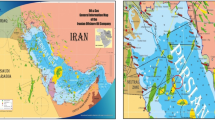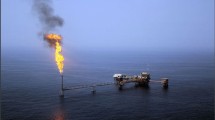Abstract
The development of robust damage detection methods for offshore structures is crucial to prevent catastrophes caused by structural failures. In this research, we developed an Improved Modal Strain Energy (IMSE) method for detecting damage in offshore platform structures based on a traditional modal strain energy method (the Stubbs index method). The most significant difference from the Stubbs index method was the application of modal frequencies. The goal was to improve the robustness of the traditional method. To demonstrate the effectiveness and practicality of the proposed IMSE method, both numerical and experimental studies were conducted for different damage scenarios using a jacket platform structure. The results demonstrated the effectiveness of the IMSE method in damage location when only limited, spatially incomplete, and noise-polluted modal data is available. Comparative studies showed that the IMSE index outperformed the Stubbs index and exhibited stronger robustness, confirming the superiority of the proposed approach.
Similar content being viewed by others
References
Alvandi A, Cremona C, 2006. Assessment of vibration-based damage identification techniques. Journal of Sound and Vibration, 292(1-2), 179–202. DOI: 10.1016/j.jsv.2005.07.036
Doebling SW, Farrar CR, Prime MB, 1998. A summary review of vibration-based damage identification methods. Shock and Vibration Digest, 30(2), 91–105. DOI: 10.1177/058310249803000201
Entezami A, Shariatmadar H, 2014. Damage detection in structural systems by improved sensitivity of modal strain energy and Tikhonov regularization method. International Journal of Dynamics and Control, 2(4), 509–520. DOI: 10.1007/s40435-014-0071-z
Farrar CR, Doebling SW, Nix DA, 2001. Vibration-based structural damage identification. Philosophical Transactions: Mathematical, Physical and Engineering Sciences, 359(1778), 131–149. DOI: 10.1098/rsta.2000.0717
Hillis AJ, Courtney CRP, 2011. Structural health monitoring of fixed offshore structures using the bicoherence function of ambient vibration measurements. Journal of Sound and Viration, 330(6), 1141–1152. DOI: 10.1016/j.jsv.2010.09.019
Kim JT, Stubbs N, 2002. Improved damage identification method based on modal information. Journal of Sound and Vibration, 252(2), 223–238. DOI: 10.1006/jsvi.2001.3749
Li Huajun, Wang Junrong, Hu S-L J, 2008. Using incomplete modal data for damage detection in offshore jacket structures. Ocean Engineering, 35(17-18), 1793–1799. DOI: 10.1016/j.oceaneng.2008.08.020
Li Huajun, Yang Hezhen, Hu S-L J, 2006. Modal strain energy decomposition method for damage localization in 3D frame structures. Journal of Engineering Mechanics, 132(9), 941–951. DOI: 10.1061/(ASCE)0733-9399(2006)132:9(941)
Mojtahedi A, Lotfollahi Yaghin MA, Hassanzaheh Y, Ettefagh MM, Aminfar MH, Aghdam AB, 2011. Developing a robust SHM method for offshore jacket platform using model updating and fuzzy logic system. Applied Ocean Research, 33(4), 398–411. DOI: 10.1016/j.apor.2011.05.001
Nichols JM, 2003. Structural health monitoring of offshore structures using ambient excitation. Applied Ocean Research, 25(3), 101–114. DOI: 10.1016/j.apor.2003.08.003
Seyedpoor SM, 2012. A two stage method for structural damage detection using a modal strain energy based index and particle swarm optimization. International Journal of Non-Linear Mechanics, 47), 1–8. DOI: 10.1016/j.ijnonlinmec.2011.07.011
Simoen E, Roeck GD, Lombaert G, 2015. Dealing with uncertainty in model updating for damage assessment: A review. Mechanical Systems and Signal Processing, 56-57), 123–149. DOI: 10.1016/j.ymssp.2014.11.001
Stubbs N, Kim JT, Farrar CR, 1995. Field verification of a nondestructive damage localization and severity estimation algorithm. Proceedings of International Modal Analysis Conference, 210–218. DOI: 10.1007/s004150050442
Titurus B, Friswell MI, Starek L, 2003. Damage detection using generic elements: Part II. Damage detection. Computers and Structures, 81(24-25), 2287–2299. DOI: 10.1016/S0045-7949(03)00318-3
Wang Shuqing, 2013. Damage detection in offshore platform structures from limited modal data. Applied Ocean Research, 41), 48–56. DOI: 10.1016/j.apor.2013.02.004
Wang Shuqing, Li Huajun, 2012. Assessment of structural damage using natural frequency changes. Acta Mechanica Sinica, 28(1), 118–127. DOI: 10.1007/s10409-012-0017-7
Wang Shuqing, Li Huajun, Takayama T, 2005. Modal identification of offshore platforms using statistical method based on ERA. China Ocean Engineering, 19(2), 175–18.
Wang Shuqing, Liu Fushun, 2010. New accuracy indicator to quantify the true and false modes for eigensystem realization algorithm. Structural Engineering and Mechanics, 34(5), 625–634. DOI: 10.12989/sem.2010.34.5.625
Wang Shuqing, Liu Fushun, Zhang Min, 2014. Modal strain energy based structural damage localization for offshore platform using simulated and measured data. Journal of Ocean University of China (Oceanic and Coastal Sea Research), 13(3), 397–406. DOI: 10.1007/s11802-014-2028-4
Wang Shuqing, Zhang Jian, Liu Jinkun, Liu Fushun, 2010. Comparative study of modal strain energy based damage localization methods for three-dimensional structure. Proceedings of the 20th International Offshore and Polar Engineering Conference, Beijing, 4), 398–403.
Yan Wangji, Huang Tianli, Ren Weixin, 2010. Damage detection method based on element modal strain energy. Advances in Structural Engineering, 13(6), 1075–1088. DOI: 10.1260/1369-4332.13.6.1075
Yan Wangji, Ren Weixin, Huang Tianli, 2012. Statistic structural damage detection based on the closed-form of element modal strain energy sensitivity. Mechanical Systems and Signal Processing, 28), 183–194. DOI: 10.1016/j.ymssp.2011.04.011
Author information
Authors and Affiliations
Corresponding author
Additional information
Foundation item: Supported by the National Natural Science Foundation of China (51209189, 51379196), the Natural Science Foundation of Shandong Province (ZR2013EEQ006, ZR2011EL049), and the Taishan Scholars Program of Shandong Province
Rights and permissions
About this article
Cite this article
Li, Y., Wang, S., Zhang, M. et al. An improved modal strain energy method for damage detection in offshore platform structures. J. Marine. Sci. Appl. 15, 182–192 (2016). https://doi.org/10.1007/s11804-016-1350-1
Received:
Accepted:
Published:
Issue Date:
DOI: https://doi.org/10.1007/s11804-016-1350-1




